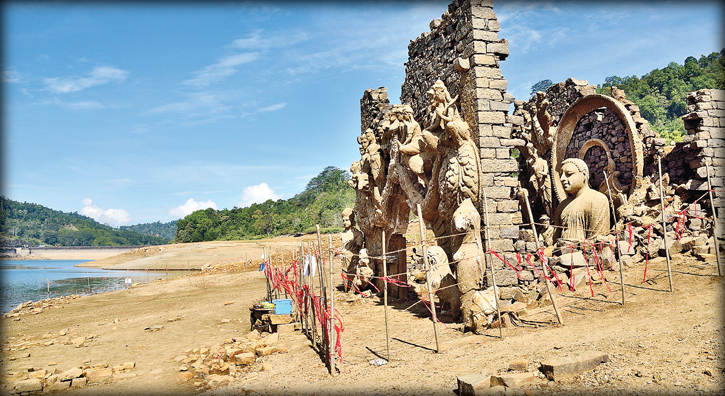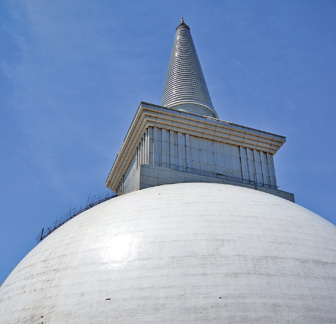The rise of Kadadora
|

Re-emerged Buddha statue and ruined shrine room of Kadadora
Sri Priyabimbaramaya |
Submerged in the Kotmale reservoir, this historic village and its
various temples have surfaced for the first time in 35 years:
Story and pictures by Mahil Wijesinghe
Drop in water levels at the many reservoirs courtesy El Nino weather
conditions had me making tracks to the Kotmale reservoir for a glimpse
of the Kadadora Sri Priyabimbaramaya Vihara, one of the ancient temples
that went underwater when the Kotmale reservoir came into being.
The diminishing water levels meant the Vihara was visible in all its
ruined glory for the first time in 35 years.
No wonder the reservoir has become a tourist magnet, with large
groups thronging to reservoir bed several to pay homage to the
spectacular Buddha statues of the KadadoraVihara.
Kotmale Valley
The journey was exciting because of the anticipation. Driving along
the Nawalapitiya-Harangala road, I marvelled at the mountain range
giving shelter to the Kotmale Valley as I passed Hapugasthalawa. The
Kotmale Oya was reduced to less than a trickle in various places, and as
I traversed along Harangala, could see the pinnacle cast of a Chaitya...
a few years on the Kotmale dam emerged, and all too soon I had arrived
at the Kotmale reservoir.
According to historical notes, Kotmale in the 2nd Century BC was the
place where young Dutugamunu, the heroic King to-be, lived among the
peasants. Kotmale belonged to Malaya Rata.
The village of Kadadora is believed to be one of the four entrances
alongside, Watadora, Niyangandora and Galdora, to and from the Ruhuna
Kingdom to the Maya Kingdom.
|

The enchanting Mahaweli Maha Seya (Chaitya) |
|

The picturesque dried up Kotmale reservoir seen from
KadadoraVihara |
|

Ruins of a Bodhigaraya (Bo-tree enshrine) at Kadadora temple |
As such, historical records state that Prince Dutugamunu entered the
Malaya Rata from Kadadora, which also happened to be the place where he
hid his royal sword upon entrance.
During the years spent in Kotmale, it is said Prince Dutugamunu
engaged in farming in Masswela and legend has it that he had a love
affair with a village maiden named Ran Menika, whose father was a
village headman of Urupalassa, where Prince Dutugamunu had hid. At
present, this location is known as Kotagepitiya. Furthermore, it is said
that hiding in Kotmale, young Prince Dutugamunu had acquired weapons for
his planned military campaign against the Chole King, Elara.
Seven Ratas
During the Kandyan period, Kotmale became one of the seven Ratas of
the Kandyan Kingdom. It came under the Gampola Kings during the Gampola
Period in the 14th century.
In 1977, the UNP led government decided to accelerate Mahaweli Ganga
development program, damming five major reservoirs. The Kotmale project
was one of the five major projects proposed under the Accelerated
Mahaweli Development program. The basic element of the project was a dam
at an elevation of 2,100 feet above the sea level on the Kotmale Oya,
which is the main tributary of the Mahaweli Ganga.
Spread across a land area of 2,270 ha, the Kotmale reservoir, which
embraces lands from both Kandy and Nuwara Eliya Districts, is nestled
between Tispane and the Kadadora hills. The dam site was located at the
historic Kadadora. This resulted in the displacement of 3,300 families
from their ancestral homeland and the submerging of the Kotmale valley,
after the dam was constructed. The picturesque Kotmale reservoir was
impounded in November 1984.
However, 57 villages and about 54 ancient temples, among others are
said to have gone under water when the reservoir was built. While many
of these temples do not exist at present, some of them still do, even
though fully submerged.
Bittersweet reminder
Among these, the ruins of the Kadadora Sri Priyabimbaramaya are
spectacular, especially the sculptured statues of the Buddha and other
deities. However, they are a rare sight and can be only viewed according
to the whims of the weather gods.
These ruins, which lie nestled under the water for more than 30
years, are a nostalgic reminder of the past life of Kadadora village in
Kotmale valley. They make rare reappearances during severe droughts in
what is a bittersweet reminder of how the people are suffering.
Mahaweli Maha Seya
These rare situations also provide bittersweet opportunities for some
of the villagers whose homes went under water to give birth to the
Kotmale reservoir, to revisit the past and reminisce about the days gone
by.
The temples completely submerged by the reservoir are Sri
Priyabimbaramaya-Kadadora, Sri Subaddraramaya-Thispane, Devale-Morape,
Bodirukkaramaya-Othalawa and Pattini Devale andGangaramaya-Medagoda.
On the right bank of the Kotmale dam at Kadadora, facing the
reservoir, a massive Mahaweli Maha Seya (Chaitya) has been built to
symbolise the religious aspirations of the people whose Viharas and
Devales were lost forever due to the Kotmale project. Rising to a height
of 247 feet from the ground and having a 238 feet diameter, this Chaitya
stands as a monument to the people of Kotmale. |

